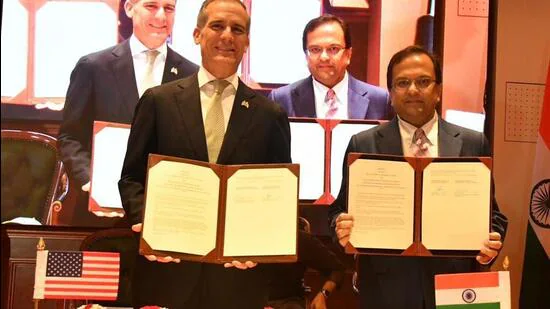India-US Cultural Property Agreement
India and the United States have signed a History-Making Cultural Property Agreement in their first pact to curb illicit trafficking of antiquities. The agreement was signed during the ongoing 46th World Heritage Committee, which the host, India. The CPA marks a giant leap towards preserving and conserving India’s rich and diverse cultural heritage. A New Dawn for Cultural Cooperation India’s Culture Secretary Govind Mohan and US Ambassador to India Eric Garcetti signed the Cultural Property Agreement in the presence of Union Minister of Culture and Tourism Gajendra Singh Shekhawat.

The Reach and Effect of the Deal
The smuggling of cultural property plagues many cultures worldwide including India for a long time. The 1970 UNESCO Convention, by the way, came a few decades too late: much looting was done before this convention went into effect. These cultural treasures are now in museums and institutions, as well as private collections throughout the world. Indian authorities have repatriated 358 antiquities since 1976, with the bulk of them – or about 345 objects since November in cooperation “with a number of countries”, mostly from the US.
The new deal is expected to fast-track and simplify the extradition process. The US alone returned 1,440 artefacts in 2023 An Archaeological Survey of India (ASI) team inspected these goods and found nearly 300 artefacts qualified beneath the “antique” category. The CPA is in line with the 1970 UNESCO Convention on the “Means of Prohibiting and Preventing the Illicit Import, Export and Transfer of Ownership of Cultural Property,” to which both countries are signatories. Minister Shekhawat lauded the deal, observing, “This is another important step in securing India’s rich, diverse, and invaluable artefacts of our proud history.
Dedication To Justice And Cultural Unity
U S Ambassador, Eric Garcetti also stressed the importance of this agreement and said People can take a lot from us because they were colonized but even after independence we did not return everything to India. This is a covenant of two parts – the cultural property agreement. One is for justice and the other one to globalize India, because every Non-Indian American or any people from around the world who are not Indian has a right to know that what we celebrate here today. We can share that now legally with this agreement. The accord is the finding of a year-long process of bilateral conversation and negotiation through G20 culture working group sessions. This is also a proof of culture being recognized as an objective in its own right under the post-2020 development framework identified by the Leaders’ Declaration (NDLD), New Delhi.
During his recent visit to the US, Prime Minister Narendra Modi had thanked America for return of Indian antiques. The Cultural Property Agreement reflects robust cooperation between the nations to combat illicit traffic in cultural objects. With this announcement, India now becomes the 30th partner nation with a bilateral cultural property agreement in effect between it and the US. US State Department negotiated CPA under US law: This involves the 1970 UNESCO Convention. The US and India signing the Cultural Property Agreement is a big step towards safeguarding Indias heritage This agreement is proof of a desire for justice and maintains cultural connection as both countries work together to curb the illegal traffic in antiquities and repatriate them. Keep checking Samayajyothi for the latest news and analysis on this and all major cultural heritage-related issues.
Stay tuned with Samayajyothi for more updates and long news about this historic agreement, other cultural stories.
Share this post :
KTR Accuses Revanth Reddy’s Brother-in-Law of Securing Lucrative Government Contracts with Minimal Business Background
NASA says: Two Big Space Rocks To Dangerously Flyby Earth Today
Wayanad Landslides- Army Rescues Thousands From Cloudburst, Managed To Save More Than 190 Others
Incredible image from NASA’s Juno mission shows Jupiter as we’ve never seen it before
Subscribe our newsletter
Purus ut praesent facilisi dictumst sollicitudin cubilia ridiculus.